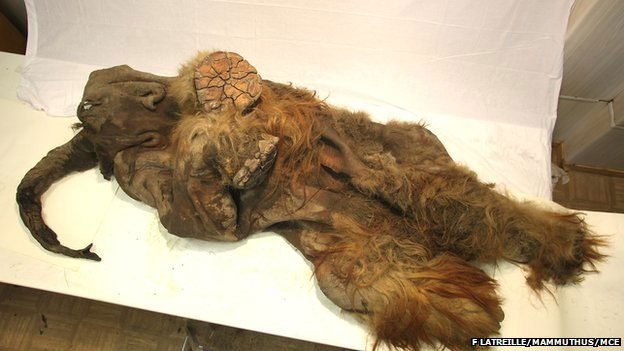Find the remains of the mammoth intact
The body of a small mammoth has just been found in the permafrost of Siberia. It seems to have been cut into many parts by ancient hunters.
>>>New discovery from fossils of two mammoths
The extremely well preserved elephant named 'Yuka' has been found in Siberia, which is 10,000 years old, if not older. If further research confirms the initial conclusion, this is the first mammoth corpse to show that humans have intervened in this area.
The remains of the corpse also include pink flesh and golden fur. It seems that humans have cut the mammoth meat at least 10,000 years ago.
The elephant's body was so well preserved that much of its meat was unharmed, and still retained its pink color. The yellow fur is also intact.

Yuka is almost intact.
'This is the first almost complete mammoth corpse to be found - including well-preserved soft fibers - evidence for the role of humans in this area,' said Daniel Fisher, manager. and the director of the University of Michigan Paleontology Museum, said.
GS. Fisher worked with an international team of experts to analyze Yuka. The mammoth hunter Bernard Buigues at the scientific organization "Mammuthus" saved the specimen from falling into the hands of private collectors.
Although the method of carbon identification is not working, researchers believe that Yuka died at least 10,000 years ago. The elephant survived half a life at the time of death.
'It seems that Yuka has been chased by a few monsters or a large animal, so it has some skin scratches and bites on the ears. Then Yuka fell to her knees. At this point, it is possible that humans were present to take the body, cut the elephant's flesh to get the parts they could use immediately , " Fisher said.
'Maybe they buried the corpses for preservation to use later. The part we find today is the rest that they don't touch anymore. '
Yuka's body has just been found to have internal organs, spine, ribs, muscles and some thigh muscles. The lower part of each leg and the elephant's body remain intact.
Maybe the people at that time liked the big fat and bones of the animal, or maybe they took big bones for some religious ritual.
- Detecting mammoth remains with soft tissues and feathers
- Display of mammoth corpses intact
- Detecting intact mammoth corpses in the North Pole
- Discovering mammoth bones near Paris
- The thousand-dollar mammoth remains buried in ancient ice
- Study mammoth brain
- The mystery of the corpse after 23 years remains intact
- 42,000 year old mammoth exhibition
- The 700,000-year fossil suspected to be 'precious' mammoth
- Mammoth exhibition 39,000 years ago
- Find the smallest mammoth
- Germany: Detects an 35,000-year-old ivory mammoth
 Discovered an ancient centipede fossil 99 million years old
Discovered an ancient centipede fossil 99 million years old Discovered bat-like dinosaurs in China
Discovered bat-like dinosaurs in China Discovered a 200-year-old bronze cannon of the coast
Discovered a 200-year-old bronze cannon of the coast Discover 305 million-year-old spider fossils
Discover 305 million-year-old spider fossils